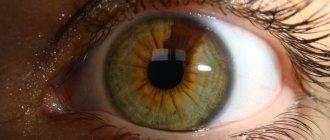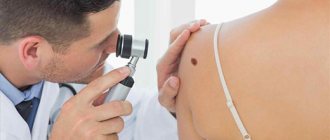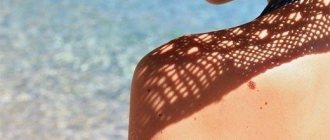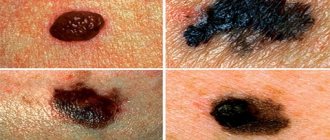Dermatovenerologist
Khasanova
Alina Rashidovna
7 years experience
Make an appointment
A mole is a benign formation that appears on the skin. Its key feature is pronounced pigmentation against the general background of the skin.
These pigments begin to appear at an early age. Children and adults have them. On the one hand, their presence does not cause any concern. On the other hand, moles from a benign formation can “grow” into a malignant one. Therefore, at the first signs of changes and severe symptoms, you should consult a specialist.
In professional medicine, a mole has another name - nevus. In general, this is not a strict medical concept; the word is used to unite various neoplasms that differ in nature.
Warning: mole
All pigmented moles are considered benign neoplasms and in 90% of cases, they never degenerate into something more terrible
All pigmented moles are considered benign neoplasms and in 90% of cases, they never degenerate into something more terrible. However, it is worth protecting them from damage and exposure, including exposure to the sun. You should pay attention to the following points if:
- suddenly many moles appeared on the body.
- the edges of the nevus become uneven;
- the color of the spot changes;
- the mole quickly grows in width or upward;
- the skin on it cracks, hurts, itches.
Laser mole removal is fairly safe. But doctors believe that if a mole does not bother you and sits tightly on the body, then it is better to leave it alone. Moles are often removed on the collarbones, where they can be easily torn off or rubbed by a bra strap or handbag, as well as on the arms, legs, and lower back.
To reduce the risk of nevi degenerating into cancerous tumors, after 30 years of age, limit trips to the solarium and try to spend less time in the open sun. Sunscreen is required before going to the beach and after swimming. Cosmetics with ultraviolet filters will prevent the appearance of moles on the face in winter.
When is it recommended to see a doctor?
Whether it’s good or bad when a person has many birthmarks, there is no clear answer. After all, a large number of moles is not an indicator that one of them will be malignant.
For example, small pigment spots do not pose a threat to life and health, since they never degenerate into malignant formations. But the accelerated appearance of a significant number of moles in a short period of time, an increase in their size, and a change in structure pose a danger of degeneration into melanoma.
Every person who has many moles should know the signs of a dangerous neoplasm:
- bleeding occurs, ulceration of the surface is noted;
- there is a change in the shape of the nevus (uneven edges, asymmetrical shape, heterogeneous structure);
- rapid development of the tumor occurs;
- itching occurs at the site of the lesion;
- there is pain;
- there is a change in color intensity (uneven coloring);
- small cutaneous or subcutaneous formations appear near the nevus;
- lymph nodes become enlarged.
If any of the above symptoms occur, you should immediately consult a doctor -
oncologist and undergo the necessary examination.
What is a mole
A mole is a pigmented formation on the skin. It occurs by overcrowding cells with melanocytes. In other words, a mole appears in a place where the accumulation of melanocytes is too high. The medical name for a mole is nevus. Nevus is absolutely not dangerous, since it is a benign formation.
If moles on the skin do not bother or cause discomfort, then there is nothing wrong with it. Even if there are very large numbers of moles on the body. If a mole suddenly begins to grow, itch, bleed, or change color, then this should alert you.
If you notice any unusual changes, it is best to consult a dermatologist immediately. Sometimes a mole can develop into a malignant one, but this is very rare. This formation is called melanoma. This is a type of cancer that develops very rapidly and has quite serious consequences.
What symptoms should you see a doctor for?
In dermatology, there is the concept of “chord”, which means a number of signs of a change in a mole; you must immediately consult a dermatologist. If a mole becomes asymmetrical, its edges are uneven, it bleeds, it has an uneven color from pink to brown, its size is more than 5 mm, there are dynamics in the change in condition, then the patient should immediately show the nevus to an oncodermatologist.
The patient’s task, if moles appear in large numbers on parts of the body, is to eliminate provoking factors, get rid of pigment spots that disturb the aesthetics of the body, observe the condition, the dynamics of changes in shape, color and size. Don't be afraid of pigmentation. Proper body care, observation by a qualified doctor and removal of defects using the achievements of modern cosmetology reduce the risk of developing melanoma to a minimum.
Why moles appear
Most moles appear at the age of 10 years. There are cases when a child is born with moles. This is a rare but completely normal occurrence. It is believed that moles appear during the period of hormonal changes in the body.
Most often, nevi appear during puberty, that is, at the age of 11–14 years. Hormonal changes are observed during pregnancy, menopause, while taking certain medications and after abortion.
Women are more susceptible to hormonal changes than men. This is why females have more moles. Also, women often have moles on the mucous membranes. Moles may appear during pregnancy, and this is quite normal.
The appearance of moles is very common in pregnant women. Most mothers in this case run to the hospital for help or look for salvation on the Internet or reference books. To solve the problem, it is enough to find out what a mole is and why they appear.
What formations need to be removed
The decision is made by the woman after visiting a dermatologist or oncologist. Excision must occur in a medical facility.
Traditional medicine methods are dangerous and can accelerate the growth of spots or lead to malignancy. First, a study of the material is carried out.
Nevi to be removed:
- Subject to constant injury, for example from a bra.
- Causing aesthetic discomfort.
- If degeneration is suspected.
Factors contributing to the appearance of new moles
It must be said that there are people whose bodies are covered with many moles. There are others who have virtually no moles. Newly born babies do not have pigmentation, and only with age, usually in the second year of life, moles appear. Nobody usually pays attention to the first moles - they are so invisible.
At the age of puberty, new moles appear. For some people, old moles only change during a hormonal surge. The increase in the number of moles is influenced by changes occurring in the body. In addition, moles can change color, size, become darker or brighter.
Pregnancy can also provoke the appearance of new moles. Direct sunlight contributes to the appearance of moles on the body.
Key properties
Moles are divided into flat and convex. When they rise above the skin, a person experiences some discomfort, especially if they are formed in places of close contact with clothing. Such nevi require immediate removal so that the owner cannot damage them by accident.
This procedure should be carried out in the office of a dermatologist. Any impact on the nevus, including cauterization, can harm the body.
In addition, doctors, before resorting to removal, examine the stain in detail to find out its origin. Laboratory testing may be required. It would seem that this is just a formality, but sometimes neoplasms can develop into tumors, so there is no need to doubt the feasibility of such procedures.
For example, raised red moles can sometimes be completely unpredictable. They form when an individual blood vessel has been damaged. Their nature is benign, but their mass education can lead to suspicion. If they are scattered singly throughout the body, they disappear on their own over time. The appearance of entire groups of hemangiomas may indicate a hormonal imbalance.
To understand why moles appear on the body of an adult, it is necessary to understand the connection between the condition of the skin and various processes taking place in the body.
What is a mole
A mole is a pigmented formation on the skin
A mole is a pigmented formation on the skin. It occurs by overcrowding cells with melanocytes. In other words, a mole appears in a place where the accumulation of melanocytes is too high. The medical name for a mole is nevus.
Nevus is absolutely not dangerous, since it is a benign formation. If moles on the skin do not bother or cause discomfort, then there is nothing wrong with it. Even if there are very large numbers of moles on the body. If a mole suddenly begins to grow, itch, bleed, or change color, then this should alert you. If you notice any unusual changes, it is best to consult a dermatologist immediately. Sometimes a mole can develop into a malignant one, but this is very rare. This formation is called melanoma. This is a type of cancer that develops very rapidly and has quite serious consequences.
Increase in the number of nevi
Moles form especially actively before the age of 30. If they appear in large numbers in an elderly person, he should seek advice. These formations can form anywhere, but those located on the back should be given maximum attention. An independent monthly examination using a mirror will come to the rescue.
Medical examinations are carried out by a dermatologist. If he suspects melanoma, he refers the person to an oncodermatologist. The mammologist evaluates the nature of the formation if it was found on the chest. If you can’t make an appointment with a dermatologist, you should at least go to a therapist. The likelihood of developing melanoma increases if you have relatives who have had this pathology. Hormonal changes in the body are also unfavorable. An example would be pregnancy, menopause, or recent abortion.
A special category consists of people with light hair and skin color, as well as redheads with a lot of freckles. Adverse consequences can be expected in the future if the mole is injured by underwear straps or any other tight clothing. Experts around the world say that to prevent new growths on the skin, you should go to the solarium and sunbathe less. In women, melanoma is more often found on the skin of the legs, in men - on the stomach and back.
It happens that a mole rises above the surface of the skin and causes discomfort, but independent removal is contraindicated. Such manipulations can provoke the formation of a tumor. This process should only be trusted by a specialist.
If many moles have formed on the body, the reasons for their appearance in old age may be unfavorable.
Where nevi can come from in the absence of obvious predisposing factors can be determined by an analysis of the family history of the disease. There is probably a hereditary predisposition.
Interesting and important facts
When a woman is pregnant, she experiences a crazy surge of hormones during lactation. This is a consequence of the fact that during pregnancy the body works for two, which is a lot of work for it. Hormones that are produced in double volume come to the rescue. This helps to cope with the load. The appearance of moles during pregnancy indicates that the hormonal system is working perfectly. Sometimes nevi disappear after a while, but this is not a reason to panic. More often than not, they last a lifetime and remind you of a wonderful time in your life.
It is worth paying attention if moles that appear during pregnancy begin to bother you. In principle, this applies not only to new but also to old formations. If you notice a change in color, swelling, itching or burning, consult a specialist immediately. This often happens in pregnant women due to hormonal explosions. After childbirth, everything falls into place. Such places need to be carefully monitored so as not to cause harm. Try to avoid exposure to ultraviolet rays on these areas, do not scratch or press.
A specialist will help you understand the cause of discomfort. Alternatively, your doctor may suggest removing the mole to avoid the risk of developing melanoma. But this is already an extreme case. Often, pregnant women develop moles, but most often doctors do not remove such formations so as not to bother the mother and baby.
Removal method
After the decision to remove is made, a treatment method is selected. It will depend on the result obtained and the clinic’s equipment.
- The most accessible method is surgical removal with a scalpel. A large amount of tissue is affected. The operation is painful and local or general anesthesia is used. Rough scars remain. Therefore, the method is usually used for large formations.
- Cryodestruction is based on freezing a part of the body. Cooled liquid nitrogen or carbonic acid kills the cells of the spot to form a crust. Healthy young tissue grows underneath. The technique is less traumatic than using a scalpel. Does not leave scars and does not cause pain. But there is a risk of incomplete removal, after which the procedure has to be repeated. Cryodestruction is used to treat small flat spots.
- Electrocoagulation, on the contrary, is based on tissue cauterization. There is virtually no bleeding, the volume of excision is minimal. But the pain is higher, the affected tissue may also remain.
- Laser removal is used in beauty salons to remove small lesions. The radiation penetrates deeply, but does not leave defects on the surface of the skin. The patient does not feel pain. Disadvantage of the procedure: the likelihood of leaving part of the nevus. White spots often remain.
- Radiosurgical techniques have gained popularity in recent years. A special knife emits radiation that destroys the affected area and does not affect the healthy one.
When can I delete
If there are no medical indications for urgent excision, choose a good time for the procedure and follow the advice:
- If you are afraid of rough scars and stains, it is best not to remove them in the summer. Protect your body from ultraviolet radiation for about 2 months; if this is not possible, use products with SPF 50 protection.
- Do not visit the solarium.
- Address chronic illness issues early.
After a woman has removed a mole, she should not apply foreign agents to the gland. For the first day, avoid water treatments. You can cover the wound with a band-aid until a crust forms. Antibiotics are generally not required. Alcohol is not prohibited.
It is better to postpone surgery in the following cases:
- pregnancy;
- If you have a pacemaker, electrocoagulation cannot be used.
Why are there many moles on the body?
The second reason for the prevalence of moles is liver disease.
There are several reasons, and each of them is expressed in the characteristics of the human body. Such factors as astrology, esotericism, and the character of a person have absolutely nothing to do with it. Just an organism. So, most often people who have fair skin have a lot of moles. It contains a little melanin, and it does not spread throughout the skin, but is concentrated at certain points.
They are pigment spots. The second reason for the prevalence of moles is liver disease. At the same time, it is not necessary for the liver to hurt: it can be destroyed completely unnoticeably. The third significant reason is the incorrect distribution of human energy. If he is angry too much or, conversely, sad too little, being constantly cheerful and welcoming, his energy meridians are disrupted, causing moles to appear on the skin for the first time already in a person’s conscious age. These, in fact, are all the possible reasons for the massive appearance of birthmarks.
Why moles grow: what is the reason and how to avoid this growth
Why does a person need moles on his body?
Many people are interested in why nevi are needed on the body. Probably, it is possible to explain the benefit of any formation on the body, the necessity of any human organ, etc., but nevi have no significance, in essence. However, birthmarks, dots and bumps appear in those places where the most pigment is accumulated in the skin cells. In these places, growing moles appear on the body, which are benign neoplasms. Some of them can degenerate into malignant melanomas and cancer.
It turns out that a mole on a person’s body is a harbinger of possible danger, signs that are important to pay attention to. If you monitor the health and growth of nevi on the body with due attention, you can avoid the most unfavorable consequences. In fact, this is the only useful property of pigmented spots. By removing a nevus, you also lose the possibility of cancer arising from the accumulated pigments, but it is not at all necessary to remove all nevi on the body, especially if they do not bother you.
In addition to the medical justification for the need for nevi, there are various unproven theories:
- Tibetan. She says that nevi appear where your chakras were incorrectly opened or affected by negative energy. But there is also a coincidence with modern medicine - you need to pay attention to these points in order to maintain health;
- Folk. According to this theory, every nevus on the body symbolizes something, be it luck, power, love of travel, danger or something else. There is also an opinion that when a mole begins to grow, the influence of its significance on your life increases, and if the nevus begins to decrease, then its significance decreases.
It is not known whether to believe these theories, because... there is no scientific evidence of their veracity, but monitoring moles is important to preserve your life.
Why nevi appear on the body
Questions of interest to everyone: why do moles grow and why do they appear in the first place? The first pigmented spots can be noticed on the child’s body already in the first year of life, less often - they appear immediately after birth and are congenital.
INTERESTING. Birthmarks that appear at birth are a malformation of the skin, and nevi that appear throughout life are benign neoplasms.
However, just as nevi appear on the human body, they can just as easily disappear; you should not be suspicious of this. A nevus can also appear on any part of the body, including the genitals, even on the mucous membranes.
What are the reasons for the appearance and growth of nevi identified in modern medicine:
- Genetics. This reason is the most serious, it cannot be changed or corrected, or limited. Hence the name moles - they are passed on to us through our parents at the genetic level. If your close relatives have a large birthmark, then most likely both you and your children will have one;
- Hormones. The body is rebuilt for various reasons, but this is always accompanied by disruptions in the hormonal background, when there are either declines or surges in hormone levels. It is incredibly simple to explain: under the pressure of hormones, melanin is formed, which affects the appearance of new age spots. Most often, hormonal instability occurs in pregnant women and adolescents;
- Ultraviolet. UV rays irradiate the skin through the sun and solarium, they lead to nevi appearing on the skin, and they also affect why moles grow on the body. In this situation, you again cannot do without melanin, which is produced under ultraviolet radiation;
- Injuries and illnesses. All kinds of human viruses and injuries to the nevus can affect the enlargement of the mole and the formation of new ones nearby. Skin abrasions and injuries, insect bites, radiation and x-rays can also cause the appearance of new age spots.
As you can see, there are many reasons for the appearance of new nevi, and each of them can be encountered in everyday life, especially if, due to a number of circumstances, you combine several risky possibilities for the degeneration of moles.
What explains the growth of moles
There may be many reasons why a mole grows quickly, but what explains this in the first place and what you should pay attention to in order not to start the process of nevus degeneration is not known for sure. While children are small and cannot independently take care of themselves and their health, parents should do this. As soon as your baby has new nevi, remember, write down or photograph them so that you can accurately tell whether the birthmark is growing or not changing over time. If changes in growth occur, you should immediately contact a specialist.
The spot may increase for the following reasons:
- This is a congenital birthmark. In this case, the growth of the nevus is a normal and necessary phenomenon. It will grow as long as the person grows, but when growth stops, the mole should also stop growing. If you are still worried, you can show the baby to a dermatologist or immediately to the surgeon Elena Vladimirovna Salyamkina;
- An inflammatory process of the neoplasm occurs, which may be degeneration of the tumor. In this case, it is necessary to remove the pigment spot so that it does not lead to infection of healthy cells and does not consume the entire body.
An adult needs to monitor their moles on their own; it is worth asking the help of loved ones to check those nevi that are located in places that are difficult for the eye to see, for example, on the back, on the neck, lower back, etc., in order to understand whether the moles are growing. It is also worth regularly being examined by a dermatologist or oncologist (the best option is an oncodermatologist).
The main explanation for the fact that the pigment spot grows is the effect of ultraviolet radiation. Everyone knows that sunbathing and being in the sun often and for a long time is harmful; this also negatively affects every mole that is exposed to direct sunlight.
How to protect nevi from danger
Most of all, dermatologist and surgeon patients are concerned about what to do if a mole grows. Your friends or acquaintances will not be able to answer this question, because experience has nothing to do with it. Each age spot on the body has its own risk of degeneration and danger, so in one person the nevus on the face is worth removing, while in another it can never harm.
In order for nevi to be protected from problems and degeneration, they must be protected:
- monitor the condition and growth of birthmarks;
- do not try to get rid of nevi on your own, using folk remedies or from a cosmetologist;
- avoid excessive tanning, use sunscreen and wear clothing that covers your body (even light or transparent);
- Regularly make an appointment with a dermatologist and oncologist to check nevi (1-2 times will be enough).
A radical method of treating nevi from their degeneration into malignant tumors is the removal of growing moles. However, to do this, you must be examined by an oncologist, who will explain the reason for the growth of nevi and tell you whether removing the growing spot alone is enough. In some cases, in addition to excision of the mole, therapy (radiation, chemotherapy, etc.) is also required to prevent the development of cancer.
vip-hirurg.ru>
What does the appearance of new moles indicate?
Moles are considered benign formations, regardless of whether they are congenital or acquired. But what is the reason for the appearance of new moles? Sometimes it is simply impossible to understand this issue - it is so difficult to trace the factor that provoked the appearance of the neoplasm. In any case, if you have a lot of moles on your body, there is no need to panic.
The increased appearance of new moles on the arms, face, back, and neck may be due to the fact that these places are exposed to direct sunlight to a greater extent than other parts of the body.
However, it is known that there are no places on the body where a new mole cannot appear, including the mucous membranes.
The appearance of new moles does not necessarily indicate the presence of a symptom of their malignant degeneration. In fact, the latter does not depend on quantity, but depends on condition. If a mole has changes - redness, swelling, hardening, soreness, itching, change in shape - these symptoms may be a cause for concern. In most cases, the transformation of a mole into melanoma, that is, into a malignant mole, occurs due to the fault of its carrier: for example, a person accidentally injured it, or constantly removed hair from the mole, etc.
Prevention of occurrence
A person who has many nevi on the surface of the body thinks about preventing the appearance of new ones. Experts abroad claim that DNA contains information about the number of such neoplasms and their other features. It turns out that it is simply impossible to prevent their formation on the body.
There is another opinion, according to which the action of ultraviolet rays from the sun can not only provoke the degeneration of mole tissue into atypical ones, but also adversely affect the skin as a whole. That is why there is no point in sunbathing with a taped nevus, as some people do.
If any changes are detected and the number of nevi increases, you should not delay the examination. There are various ways to remove them. The most popular today is the use of laser, cryodestruction, and electric current. The radiosurgical method is also in demand. The most suitable option is determined by an experienced doctor. To do this, he first studies the mole and draws appropriate conclusions.
Even when we are talking about a mole that is not dangerous, it can undergo unfavorable changes if it is located on the hands, hips and lower back, as well as the chest. Nevi located here are most often damaged. Before removing them, you should get tested and consult a doctor.
A nevus can also appear after the body has experienced a hormonal shock. Small spots usually do not pose a danger unless they have an atypical color. But sometimes a whole scattering of barely noticeable pale moles may appear.
In such a situation, you can undergo an examination, but it is not a fact that this will indicate melanoma. The onset of this disease is often spontaneous, but only on a separately located nevus.
Why did a red mole appear?
It is believed that the cause of the appearance of red moles on the body of an adult may be hormonal changes occurring in the body.
A red mole consists of many microscopic vessels. It can appear, as a rule, on any part of the body. Most often, red moles occur in young children and adolescents. Perhaps because it is in childhood that the human circulatory system undergoes certain changes. Often, red moles appear on the body of adults after prolonged exposure to the sun. They can be located in different layers of the skin and in different parts of the circulatory system: arterial, capillary or venous. Treatment depends on the location of the moles.
There is no need to worry about the appearance of red moles. Most of them can appear quickly and disappear just as quickly. Only a non-standard, rapidly growing mole that changes color can be a cause for concern.
In medicine, a red mole is called an angioma. It belongs to the category of safe skin diseases. Currently, the appearance of red moles has not been fully studied and there are only assumptions as to the main reason for their origin. A red mole has one main feature: when lightly pressed on it, it becomes pale, and then returns to its original natural color.
It is believed that the cause of the appearance of red moles on the body of an adult may be hormonal changes occurring in the body.
There is also an opinion among experts that the appearance of a red mole may indicate the presence of a disease of the gastrointestinal tract (most often the pancreas).
Therefore, if a red mole appears on your body, you should think about a preventive visit to the doctor. Perhaps the alarm will turn out to be false, but in cases with your own health, it is always worth being on the safe side. Also, the cause of the appearance of a red mole may be excessively intense work of blood vessels, or a deviation in the functioning of pigment cells responsible for skin pigmentation.
Reasons for the appearance of many moles
The body's tendency to form nevi is transmitted at the genetic level. A benign formation characterized by excessive production of melanin in individual cells. Various in shape, color, size, flat, convex, hanging moles are located on all parts of the body. Require observation or removal for certain indications.
By size they are divided into small with a diameter of up to 5 mm, medium with a diameter from 5 mm to 1.5 cm, large from 1.5 cm in diameter. Nevi that occupy the area of an entire anatomical site or limb are called giant nevi. Formations over 5 mm in diameter have the greatest tendency to degeneration; small pigmentation does not threaten to become melanoma. The number of pigment spots, characteristics, and appearance change over the course of life under the influence of many factors. Lifestyle plays an important role.
External
External reasons for the appearance boil down to:
- excessive exposure to the sun during its peak activity;
- tanning in a solarium;
- skin diseases, rashes, irritation, acne.
Domestic
The internal reasons for the appearance come down to:
- intrauterine failure in the migration of cells - melanoblasts, melanocytes are formed - cells that produce pigment for coloring the skin - melanin;
- hormonal fluctuations in the body during puberty and in pregnant women.
Pigment spots acquired during life are divided into three groups according to the depth of the pigment:
- intradermal - the pigment lies in the deep layers of the skin;
- epidermal - the pigment is located in the upper layers of the epidermis;
- borderline/mixed - melanocytes that synthesize pigment are localized at the border level between the epidermis and dermis.
Areas of hyperpigmentation look different: the first two types protrude above the skin, while the border ones do not stand out above its level.
In 95% of newborn babies, moles are not visible, with the exception of red nevi, which fade with age or disappear completely. During the first year of life, they begin to appear; at puberty, 90% of adolescents have various types of pigmentation. By the age of 25, the formation of the body ends, the number of pigment spots increases, after which the number declines, and at the age of 80-85 they all disappear.
Many moles - is it good or bad?
In fact, there is nothing good about having too many moles. There are many legends that: a person who has many birthmarks will become happy; such a person is spiritually multifaceted and intellectually gifted; moles attract good luck and repel bad luck... There are a lot of options, but all of this is just wishful thinking. In fact, there is nothing good about a large number of moles. On the contrary, British scientists have recently proven that an abundance of age spots doubles the risk of developing skin cancer for their carrier.
The same pair of genes in the human body is responsible for both the formation of moles and the risk of developing cancer. People who do not have a large number of birthmarks do not have a trace of any of these genes. Thus, you need to fight the abundance of moles, so to speak, from the inside.
However, they have one advantage. Quite a dubious plus, I must say, but scientists seem to have proven it. The fact is that a huge number of birthmarks have a beneficial effect on a person’s biological age, reducing it by 5-7 years. As a result, people with nevi are more active and internally young. Even if this theory has a scientific basis, it is unlikely that its results should be taken as an axiom. It is unlikely that they apply to everyone.
Removal methods
The method of performing the procedure depends on the equipment of the clinic, the doctor’s recommendations and the condition of the mole on the chest. Before any method is performed, the patient is first given local anesthesia for pain relief.
- Electrocoagulation. A high-frequency current is used, which not only removes the formation, but also solders the tissues underneath it. Open wounds and bleeding are not formed, so the risk of infection is completely eliminated. A crust remains at the site of the nevus, which disappears after 7-10 days.
- Cryodestruction. If the nevus is small, a cotton swab soaked in liquid nitrogen is placed on it. The melanocyte cluster is frozen so it can be easily removed. If the nevus is deep and reaches the lower layers of the epidermis, a needle is inserted into it, through which the freezing stage passes. The formation becomes crusty and is rejected.
- Laser method. The affected area of the skin is treated with a laser, which evaporates melanocytes down to the deep layers. Adjacent tissues remain intact and no burns occur on them. Methods exclude hemorrhage.
- Radio wave removal. The formation is preliminarily subjected to coagulation. After this, they are cut with a radio wave knife. The method is gentle and does not affect neighboring tissues.
- Surgical removal using a scalpel. The technique is applicable for large, hanging moles that pose a danger to the patient.
For the chest area, apply any of the above methods. None of them will lead to dysfunction of the mammary glands.
If a woman has had a nevus removed, she should undergo a proper rehabilitation period. The patient should not be exposed to direct sunlight. The removal area is treated with antibacterial agents.
Conclusion
If the nevus has grown to a large size on the breast or nipple, this indicates the possibility of a malignant formation.
If a woman does not come to the doctor for a consultation, this is fraught with a complication in the form of the transition of pathological cells to the breast area, causing oncology.
What do moles mean?
Dark signs on the feet mean a desire to travel and a frequent change of place of residence.
There are many signs associated with spots on the body. In some places this is a good sign, in others it is a warning. Turgenev in his story “Mumu” mentions that “moles on the left cheek are considered in Rus' to be a bad omen - a harbinger of an unhappy life.” In India, it was also believed that having moles on the left side of the body was bad for a woman, but good for a man.
Otherwise, the location of moles was largely interpreted quite literally:
- Moles on the head signified the degree of a person’s influence on others and his resistance to fate.
- Moles hidden by hair gave supernatural powers.
- Dark signs on the feet meant a desire to travel and a frequent change of place of residence.
- Markings on the calves are a sign of jockeys, circus performers, dancers who have a strong will, but a vulnerable soul.
- Moles on the stomach served as a sign of bad nature: craving for bad habits, promiscuity in sex. It also mattered what organ the sign was located over and what size it was.
- The signs on the back promised a righteous lifestyle, but poor health.
- On a woman's breast, small spots characterized the owner as a good mother and wife, but under the breast - as a fatal temptress.
A small brown mole on the palm had many meanings. On the Saturn line it meant a difficult fate, but right in the center, on the contrary, a happy married life. On the life line - health problems, at the base of the thumb - infertility and other problems with childbirth. Under the little finger, the forecast was more favorable: immediately below the base of the finger - success in business, and below - success in relationships.
Wherever moles are located, it is better not to pay attention to bad omens. Let them be symbols of your beauty and uniqueness.
What to do with a growing mole
Birthmarks (nevi) are an integral part of our lives. But every time we notice that a mole has grown on our body or face, we begin to worry and wonder why and what to do now. Below we will look at the main reasons for the enlargement of moles, tell you how not to miss the moment of degeneration of a nevus into a malignant neoplasm and what actions should be taken if a birthmark has increased on the face or body.
Reasons for the increase
One of the main reasons for the growth of a nevus is its mechanical damage. If you have an enlarged mole, check that nothing is interfering with it or injuring it. Most often, moles grow on the face after regular cosmetic procedures, shaving, and on the body in places of friction and contact with underwear, for example, at the level of a bra clasp.
In teenage children, nevi may increase in size due to a hormonal surge. If you notice such changes in your child, be sure to show him to a dermatologist.
There are cases when the growth of moles is affected by hormonal levels during pregnancy or menopause. There are also cases of the influence of the thyroid gland on the growth of nevi.
Sun rays also provoke an increase in moles. The vast majority of scientists argue that time spent in the open sun should be minimal, especially for fair-skinned people. Don't forget to use sunscreen. If you visit a solarium, then you need to make special stickers for moles, because in such installations ultraviolet radiation is more active.
How to recognize melanoma
If you are wondering why moles grow, then do not forget about the most serious reason - melanoma. This cancer attacks the skin of the face and body. This pathology is curable if everything is done on time. Therefore, it is important for every person to know the main distinguishing features of the degeneration of a nevus into a malignant tumor.
Often birthmarks begin to degenerate after injury. To prevent this from happening, it is better to remove moles that are at risk. Areas on the body are more often affected than on the face. Moles on the inner thighs, feet and palms are especially susceptible to degeneration.
It is worth noting that melanoma appears only in the area of moles that appear during life. They need to be monitored more closely. Congenital birthmarks rarely degenerate.
To suspect oncology, it is important to keep a record of the condition of all nevi on the face and body. First of all, attention is attracted by the increase in size and itching; pay attention to the edges of the mole; with melanoma, they become torn, and the original shape disappears.
Color also plays an important role. Nevi may become darker or, conversely, lighter than usual. In advanced cases, areas affected by melanoma begin to itch very much, and moist cracks appear on them. Inside the mole you can notice heterogeneous inclusions and veins. The appearance of such symptoms is a reason to sound the alarm. In addition, check the symmetry of large nevi.
If you detect any of the above signs, you need to consult a dermatologist. An experienced professional will examine your birthmarks and tell you what to do next. Even when diagnosed with melanoma, do not despair. In modern conditions, this pathology is treatable. If malignant degeneration is not detected, this does not mean that visits to the doctor must be stopped. To control the situation, it is necessary to undergo a preventive examination at least once a year.
Removal methods
If you decide to remove a growing nevus, you should do this only in the office of an experienced doctor and only after consulting an oncologist and dermatologist. If the removed tumor turns out to be malignant, the situation can only get worse. Oncology requires special treatment measures.
If there is no reason to worry and, according to the doctor’s opinion, you can have the nevus removed, we suggest that you familiarize yourself with the main methods. There are several of the most common methods available today:
- surgical intervention;
- laser;
- electrocoagulation;
- cryodestruction.
The surgical method is considered the most effective. Burning with liquid nitrogen is not recommended; this substance only affects the upper layers of the skin and the mole is not completely removed. Laser removal gives good results. Also, the laser does not cause pain. If you decide to do electrocoagulation, it is better to use local anesthesia. Your doctor will advise you on the appropriate method, taking into account all the characteristics of the nevus and your individual characteristics.
If you notice the active growth of a mole on your face or body, do not ignore it. The main enemy in this case is time. Degeneration is a long process that can take from 5 to 10 years, so it is in your power to prevent the development of the disease. In general, it is worth noting that not every growing mole is melanoma. Any conclusions and further actions regarding skin tumors should be made by experienced doctors.
LadyCleo.ru>
Associated signs of melanoma development
If a person develops a lot of moles in a short period of time, this does not mean that he is developing melanoma. In most cases, this is how the body reacts to external stimuli. WHO has proposed a list of signs by which you can independently suspect the presence of pathological processes and think about going to the hospital:
- Asymmetry. If you draw an imaginary line through a mole, and the two resulting halves are significantly different, this can be called the first symptom of degeneration of the neoplasm.
- Outlines. A healthy benign mole should have smooth, clearly defined edges, but a degenerating nevus will have uneven, jagged, blurred and constantly changing edges.
- Hue. Some moles are light in color, others are dark, but in most cases they last a lifetime. If the shade of the neoplasm suddenly changes to dark, this is another reason to consult a doctor.
- Size. A safe nevus does not grow, its diameter is relatively constant and does not exceed 6 mm. If the mole has grown more than 1 cm, this may be a cause for concern.
- Changes. Any sudden changes in the external signs or condition of the pigmented growth should alert you; this could be the appearance of blood or other discharge, cracks, hair, changes in shape, structure, etc.
Features of localization and non-medical interpretations
Ancestors considered age spots on the chest to be marks of the devil. Now they are no longer associated with dark forces and are considered attractive.
You may see:
- Moles on the right sternum in women are a sign of love for the opposite sex.
- Mole on left breast. Representatives of the fair sex with this placement of pigmentation are characterized by a soft and kind character. A woman who gets married is devoted to her husband and loves him.
- Moles on the solar plexus are a sign of a stable life. Such ladies do not get riches, but they do not suffer from poverty. Women with this arrangement of spots are sociable and frivolous. Such education is considered a talisman.
- A nevus located under the breast is a symbol of a boring lifestyle. The detailed designation depends on the location of the formation. Under the right - symbolizes an insidious girl who directs her negativity at her colleagues. A woman gradually destroys employees and becomes a leader or boss. If the mole is located under the left gland, it suggests the conduct of love affairs.
- The spot on the right aureole does not bode well; the girl brings grief throughout her life. According to palmists, the prediction is erroneous. They say that the placement of pigmentation brings the owner a strong family home and harmony in relationships with relatives.
- On the left halo. This part is associated with the heart; such formation implies problems with the cardiovascular system. But not all experts agree with this. A woman with such a mole is long-lived and hardy.
Interpretations of the location of nevi are conditional; everything depends on the actions and decisions of the woman.
Formation of moles
There has always been special attention to moles on the body: the usual dark spots on the skin accompany us all our lives, but few can say anything specific about them.
Those who are not very familiar with the physiology of moles, or nevi, as dermatologists call them, will be quite surprised: a newborn baby has absolutely no moles. We are not talking about birthmarks - this is a slightly different topic. And nevi themselves begin to form after the first six months of life. And this process continues constantly for different people and with different intensity. There are quite understandable reasons for this.
The nevi themselves are benign formations, and they are divided into two types according to the method of their formation:
- Vascular moles. They are formed from the capillaries of the circulatory and lymphatic systems and are colored in all shades of red.
- Non-vascular nevi. These are formed from melanocyte cells, in which melanin accumulates, giving moles a light brown to black color.
Hormonal changes
Let everyone remember when exactly too many moles began to appear on his body? If you manage to do this, the answer will be the same: in adolescence. Why? It is during puberty that the entire body is actively rebuilt, the blood boils from hormones released by the pituitary gland. And they activate the production of melanin, which acts as a founder (donor) of nevi.
The same thing happens in the body of pregnant women: they notice that many moles appear during this difficult time. If women think carefully, they will remember that before the first menstrual cycle, such marks also appeared on the body. There is nothing unusual about this: hormonal surges are one of the main reasons for the appearance of moles.
Sun rays
Another reason for the formation of small moles and a large number of them is ultraviolet radiation. This is ordinary sunlight, which greatly affects the body's production of melanin. And melanin, being in excess quantities in the body, slowly forms new moles.
Lovers of a stunning bronze or chocolate tan may notice a pattern: after excessive sunbathing, small nevi simply sprinkle on the back, arms, and thighs. Everything would be fine, but only one feature of moles makes them deadly - a completely unpredictable, unexpected degeneration into a cancerous tumor. That is, a simple rule works: fewer moles mean less risk of disease.
Other causes of neoplasms
If many moles appear on the skin after 24 years of age, pay close attention to the background radiation. Many leading experts are inclined to conclude that even a visit to fluorography, not to mention an x-ray, can lead to the beginning of the formation of a mole.
We are not talking about hard radiation - its effect on the growth of nevi has long been proven. The mechanism is still the same: radiation causes increased production of melanin in the body, and it begins to form into moles in melanocyte cells.
Many new moles appear after seemingly trivial insect bites - mosquitoes, bees, wasps. The fact is that if such wounds do not heal for a long time, they involuntarily become not only “open gates” for any infections (including papillomas), but also, by constantly irritating the skin, they can trigger the formation of nevi.
Opinion of Chinese doctors
Of course, their traditional medicine, which many are now keen on, has its own point of view on why nevi appear, and it is completely different from the generally accepted one.
According to Chinese doctors, if new moles constantly appear on a person’s skin, he is seriously ill. Diseases and inflammations of any internal organs lead to the accumulation of negative energy and its stagnation. Having reached a critical mass, this energy is released into space, and a mole is formed at the site of such a release. Whether to agree with such a theory or not is a personal matter for everyone.
Removal process
An oncologist or dermatologist examines the patient and determines the condition of the nevus. Experts strongly do not recommend removing moles in a cosmetic center, especially if moles need to be removed for children.
In a good clinic, moles can be removed without leaving a trace and painlessly. A qualified specialist removes tumors using a laser, scalpel or radio wave method.
In practice, doctors give their preference to the scalpel as the most reliable and safe method. Laser is also a great way, but it can harm the baby and leave an unsightly burn on the face. Before carrying out the procedure, you need to discuss all the advantages and disadvantages of all possible methods with your doctor, and then choose the most suitable one. Be healthy!
Similar articles
Rare types of moles
In addition to the usual dark spots, very rare types of age spots can be found on the child’s body.
The first type is hemangioma. It is a strawberry-colored bulge that is soft to the touch. They manifest themselves most often in the first week of a baby’s life, but can also be congenital. As the child continues to grow and develop, the hemangioma changes in size and may become pale. It is not harmful, so there is no need to treat it.
Also in children there is a type of nevus called “cavernous”. It consists of mature and large elements of a vascular nature. This type of mole penetrates deeply into human skin, has a bluish color and unclear boundaries. This formation is not subject to treatment. Usually by the age of 12, they go away on their own.
A fairly common occurrence is the appearance of one or several nevi on the scalp of a child, which causes concern in adults. But there is no need to panic. This arrangement of age spots can be called a reason to consult a doctor, but in most cases there is no danger.
The appearance of moles on the body of an adult. Moles. General information and warning signs
Moles, or nevi, usually form during childhood and adolescence, but adults can also develop new moles. Most moles are benign, but the appearance of new moles or sudden changes in existing moles in adults may be a sign of melanoma. Melanoma is a type of skin cancer . According to the American Cancer Society, melanoma accounts for only 1% of all skin cancers, but is responsible for the majority of skin cancer deaths.
Why do new moles appear?
A new mole appears when melanocytes, the pigment-producing cells in a person's skin, multiply or divide to form the characteristic moles that appear on the surface of the skin. Melanocytes contain pigment that provides the typical color of a mole.
Moles can be benign or malignant. Malignant moles, such as melanomas, are the result of genetic mutations. The exact cause of benign moles remains unknown.
Possible causes of a new mole include the following:
- exposure to ultraviolet radiation
- bright skin
- genetic factors
- diseases accompanied by damage to the immune system
Types of moles
Moles are divided into different subtypes depending on their properties. The following types of moles are distinguished:
Common mole
Common moles may appear at birth or later in childhood. These moles usually form on areas of the skin that are exposed to sunlight.
An ordinary mole most often has a round, symmetrical shape, a smooth surface and clear edges. Common moles are relatively small, measuring less than 5 millimeters (mm) in diameter.
These moles rarely develop into cancer. However, according to the National Institutes of Health (NIH), people with more than 50 common moles may have an increased risk of developing melanoma.
Congenital mole
Congenital moles or birthmarks are already present on the skin at the time of birth. Congenital moles can vary greatly in size, and some are quite large.
These moles are usually benign, but having a congenital mole, especially a very large one, may slightly increase your risk of developing melanoma.
According to one study, the lifetime risk of developing melanoma in people with very large congenital moles is 10% to 15%. However, these rates vary across studies.
Atypical mole
Atypical moles, or dysplastic nevi, can appear anywhere on the body and are usually larger than other types of moles.
Their color and texture may vary, and they usually have jagged edges without a clear border with the surrounding skin (blurred).
These moles are usually multi-colored, with areas of pink, red, brown, and dark brown, for example.
According to the American Cancer Society, some atypical moles can become cancerous. However, most atypical moles do not develop into melanomas.
Because atypical moles may have some similarities to melanoma, people should visit a dermatologist to make sure there are no problems.
Nevus Spitz
This rare type of mole is very similar to melanoma, but it is not cancerous. Nevus Spitz usually develops in fair-skinned children and young adults under the age of 20.
Sometimes doctors have difficulty distinguishing between a Spitz nevus and a melanoma, and may recommend removal as a preventative measure.
Spitz nevus grows quickly and can range in size from a millimeter to about a centimeter in diameter. Other characteristics of Spitz nevus include the following:
- round, symmetrical shape
- smooth surface
- star-shaped lines of pigment
Warning signs
Most moles are benign, but people should see a doctor if they notice the appearance of a new mole or recent changes to existing moles.
Warning signs to look out for when examining an existing mole:
- changes in color, shape or size
- pain
- bleeding
The American Cancer Society's ABCDE rule can be used to identify potential melanomas. ABCDE stands for:
- A – Asymmetry. One half of the mole looks different than the other half.
It is also important to examine your nails, feet, and hands, as melanomas can occur in these areas. Not all moles that appear in adulthood are melanomas. However, if a new mole appears, or if a person notices any changes to an existing mole, they should see a doctor or dermatologist for an examination. Although doctors consider melanoma to be the deadliest type of skin cancer, early detection and treatment can make a significant difference improve long-term results. Experts estimate that the five-year survival rate for melanoma diagnosed at an early stage is 98%.
Precautions and possible complications
Precautions to take if you have multiple birthmarks:
- If possible, avoid staying outside during periods of solar activity. If exposure to the sun cannot be avoided, the child should use sunscreen.
- Clothing made from natural fabrics is recommended. Avoid overheating and excessive sweating.
- If the nevus is located in places with an increased risk of injury (armpits, groin area), it is preferable to immediately carry out destruction rather than wait until mechanical damage occurs.
- In case of accidental injury to a mole, it is necessary to treat the damaged area with an antiseptic (hydrogen peroxide) and consult a doctor.
Possible complications in the presence of multiple moles:
- degeneration of benign cells into a malignant tumor;
- After the removal procedure, consequences are possible: long healing, dangerous scars and scars forming, secondary infection of the body.
In order to prevent the formation of melanoma, it is necessary to regularly examine the baby’s skin for the presence of pigment spots. To avoid tanning and sunburn, keep an eye on your child. Sunscreens reduce the likelihood of sunburn, but do not provide 100% protection against skin cancer.











